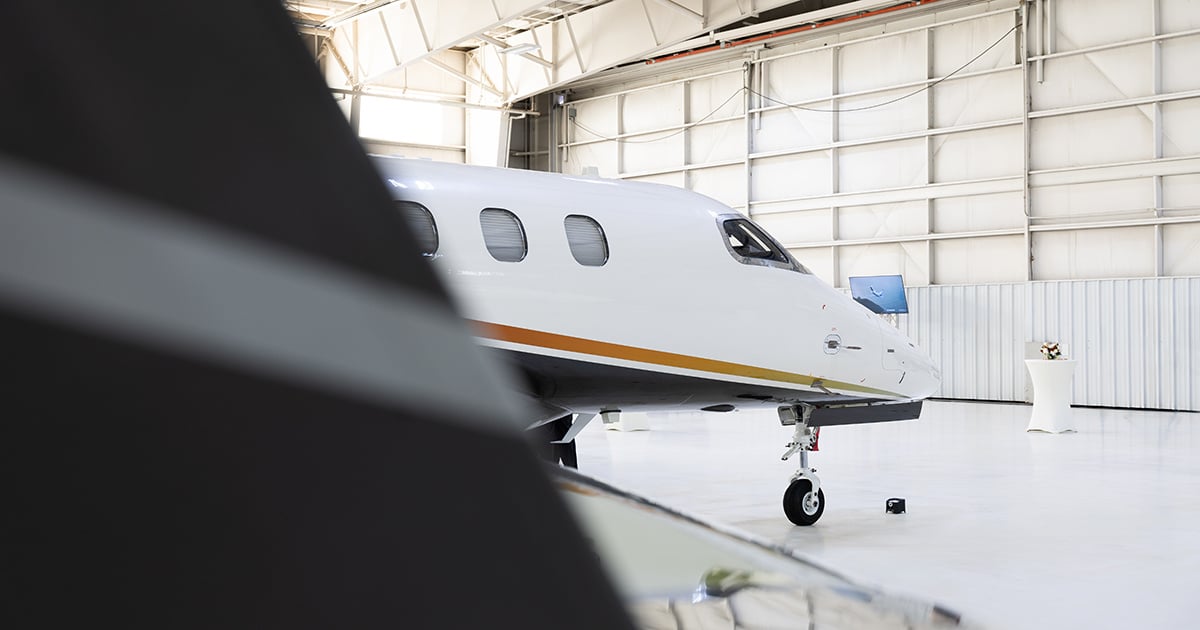|
Embraer Executive Jets today announced a $7 billion order from fractional provider Flexjet that includes firm orders for 182 aircraft—a mix of Phenom 300E light jets and Praetor 500 and 600 midsize jets—and options for another 30, as well as enhanced services and support. Deliveries are set to begin next year and run through 2030. It represents Flexjet’s largest order in its three-decade history and will nearly double the size of its fleet by 2031. The two companies have had a long relationship: Flexjet was the fleet launch customer for the Embraer Legacy 600 in 2003, Phenom 300 in 2010, Legacy 450 in 2016, and Praetor 500 in 2019. “Since 2003, we have accepted delivery of more than 150 Embraer aircraft,” said Flexjet CEO Michael Silvestro. “The Praetor 600 was so well accepted in Europe [that] we opted to include it on our North American fleet in 2023, extending our Embraer fleet across two continents.” As a result, he noted that the company’s pilots and maintenance technicians are “intimately familiar” with the type. “We are delighted with Flexjet’s renewed commitment to Embraer through this comprehensive purchase agreement, which strengthens even further our strategic partnership,” said Embraer Executive Jets president and CEO Michael Amalfitano. “We are very excited to have many more loyal Flexjet fractional owners enjoy access to our industry-leading Phenom and best-in-class Praetor jets.” |
|
|
After previously modifying a customer’s Pilatus PC-12 with Finoff Aviation’s PT6A-67P engine and seven-blade MT propeller, as well as dual Concorde batteries, Fargo Jet Center has added a full Garmin avionics suite to the airplane. The avionics upgrade includes touchscreen G600 TXi primary and multifunction displays paired with a GCU 485 PFD controller and a G600 TXi to display engine parameters. Backup is provided by a GI 275 electronic flight instrument. Two previously installed GTN 750 touchscreen navcoms were paired with a GMA 350c audio panel, Flight Stream 510 wireless gateway, and a GFC 600 autopilot under the upgrade. Dual Garmin transponders add ADS-B Out/In capability. For global voice, text messaging, position reporting, and weather updates, the Fargo Jet team installed a GSR 56 Iridium satcom transceiver. Replacing the original Pratt & Whitney Canada PT6-67B with the -67P engine enables the modified PC-12 to climb at a faster rate and cruise at higher speeds. The composite MT propeller reduces vibration, lowers noise levels by four to six dBA and cabin noise by six to seven dBA, and also improves climb performance. “Our goal is to unlock the full potential of the PC-12,” said Fargo Jet avionics lead technician Drew Stiles. “This upgrade transforms the flight deck with more advanced yet user-friendly avionics, giving operators the tools and confidence to excel on every flight.” |
|
|
Saudi Arabia's General Authority of Civil Aviation (GACA) is removing cabotage restrictions effective May 1, opening the country’s domestic private aviation market to international on-demand charter operators. The decision will allow foreign charter operators to apply for permission to conduct domestic flights within Saudi Arabia, following specific requirements set by GACA. Opening of the domestic market comes as part of GACA’s General Aviation Roadmap, which aims to transform the sector into a $2 billion industry by 2030, creating 35,000 jobs. Included in the plan is the development of six dedicated business aviation airports and an additional nine business aviation terminals. In 2024, Saudi Arabia’s business jet market saw a 24% increase in flight volumes, with domestic jet flights rising by 26% and international flights increasing by 15%. Services groups such as Jetex are already working to establish FBOs in Saudi Arabia. “GACA’s decision will have a big impact on business travel in Saudi Arabia, and I know that operators including Flexjet want to enter that market,” Jetex CEO Adel Mardini told AIN. This move is part of GACA’s broader strategy to enhance competition, attract foreign investment, and offer more flexibility to general aviation operators. In tandem, GACA is establishing a national general aviation sector development committee that will engage with international and domestic aviation stakeholders to align infrastructure and regulatory planning. |
|
|
Duncan Aviation is warning operators of aircraft equipped with certain Univeral Avionics flight management systems (FMSs) to update the FMS software before May 31 or face possible service interruptions. Delaying the upgrade may also mean vying for available slots at avionics shops, the company added. According to Duncan Aviation, the FC06 software update applies to UNS-1Espw, UNS-1Lw, UNS-1Ew, and UNS-1Fw FMSs. It changes coding for the GPS/SBAS module “to adjust the start date of the 1,024-week cycle the internal GPS uses for date calculation.” “The GPS week number rollover occurs every 1,024 weeks, or about 19.6 years. After the 1,023rd week rolls back to zero, software that is not coded to anticipate the rollover may stop working or cause the FMS to mistakenly display a date 20 to 40 years old. With the current software, the correct date will be calculated up to May 31, 2025. With the new [FC06] software, the correct date will be calculated up to Dec. 8, 2040.” Universal FMSs needing repairs can be updated during the repair process. Duncan Aviation Component Services or Universal Avionics can accomplish the applicable service bulletin update. |
|
|
Freeman Jet Center, the lone service provider at Louisiana’s Acadiana Regional Airport (KARA), has completed a major renovation of its terminal. The exterior of the building was modernized with a new roof and a metal façade, and a porte-cochère was added to the front entrance. An arrivals canopy shelters guests during aircraft arrivals and departures and airside vehicle access is now enabled through the addition of an automatic drive-through gate. As part of the project, the building was expanded by 2,000 sq ft, while the former two-story structure was transformed into a single-story design with an airy double-height lobby and a total of 4,565 sq ft of space. Terrazzo flooring and quartz countertops were also installed, along with a dedicated theater room. Other amenities feature a 10-seat conference room, pilot lounge with snooze room, and flight planning area. Also added was the Jet-A-Way Café, which serves breakfast and lunch on weekdays. Local Acadiana culture is the focus of the interior design, highlighting institutions such as Avery Island’s Tabasco production and the airport’s past as a U.S. naval aviation base. “Our newly renovated facility is a reflection of Freeman Jet Center’s dedication to delivering exceptional service and comfort,” said company CEO Scott Freeman. “We are excited to welcome customers to our upgraded amenities and invite them to enjoy the vibrant local culture woven into every detail.” |
|
|
Two years into its Take Off 2027 plan, Daher has committed to stepping up efforts to improve productivity in its aircraft and aerostructures manufacturing activities, as well as in services. Announcing a 9% revenue hike in 2024 to $1.8 billion, the French group’s chairman and CEO, Didier Kayat, told reporters today at a Paris media briefing that it faces ongoing challenges to become more competitive. Like many other aerospace companies, Daher has had to deal with an array of inflationary pressures that have driven up its costs. Kayat said these included raw materials, staff salaries, and prices charged by suppliers. With 14,000 employees on its payroll, the group has been through a rapid recruitment cycle, having hired 2,500 people in 2024. Because many of these new colleagues are relatively young and inexperienced, the company has had to invest time and resources to provide extensive training. Facing the prospect of U.S. government tariffs imposed on the European Union, Daher’s efforts to expand capacity at its aerospace production facility in Stuart, Florida, have taken on a new sense of urgency. Further construction work is set to begin in the next few weeks, and by the end of 2026 it expects to have recruited around 100 final assembly workers. Daher plans to build TBM and Kodiak turboprops in Stuart, augmenting production lines in Tarbes, France, and Sandpoint, Idaho. |
|
|
Denver-based Part 135 charter operator Precision Aircraft Management is turning to cloud-based digital aircraft records platform Bluetail to revamp its recordkeeping processes and ensure compliance for its fleet. “Our clients expect us to manage their aircraft in the safest, most efficient, and cost-effective ways possible,” said Scott Dulaney, Precision’s director of business development. “By adopting Bluetail’s proven suite of digital applications, we’re evolving into a fully paperless operation. This step not only supports our commitment to innovation but also ensures we continue to deliver unmatched service to our customers.” Operating out of four locations across Colorado, Precision’s fleet of 19 business jets includes King Air, Falcon, Citation, and Hawker models. As part of its effort to modernize its operations with more digital solutions, the company also recently added Ebis maintenance process and invoicing software, Jet Insight fleet management software, and Camp’s maintenance tracking service. This comprehensive approach will further protect the value of their customers’ aircraft while optimizing operational processes. “We’re thrilled to welcome Precision Aircraft Management to the Bluetail flock,” said Bluetail chief revenue officer Sam Celaya. “Precision’s forward-thinking approach demonstrates their leadership in aircraft management and charter operations. With Bluetail, they’ll gain the tools to securely search, share, and manage records anytime, anywhere, setting new standards in safety and efficiency.” |
|
|
|
|
|
|
AINalerts News Tips/Feedback: News tips may be sent anonymously, but feedback must include name and contact info (we will withhold name on request). We reserve the right to edit correspondence for length, clarity, and grammar. Send feedback or news tips to AINalerts editor Chad Trautvetter. |
|
AINalerts is a publication of AIN Media Group, 214 Franklin Avenue, Midland Park, New Jersey. Copyright 2025. All rights reserved. Reproduction in whole or in part without permission is strictly prohibited. |















